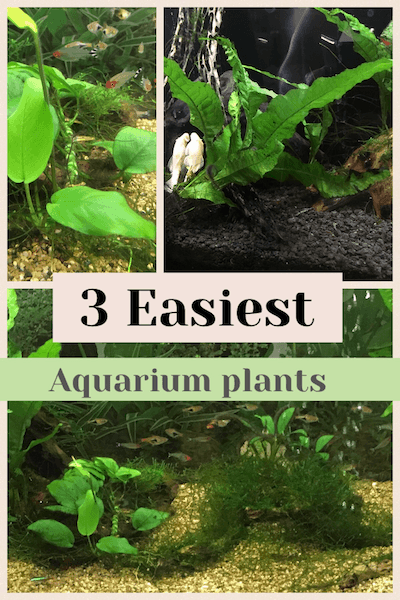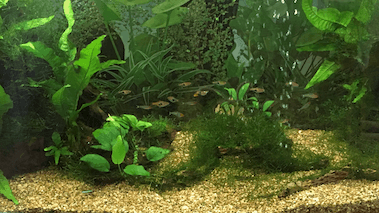
3 Easiest aquarium plants you can grow
These 3 plants are the simplest, easiest aquarium plants that anyone can grow.
-No need for special lighting!
-No special substrate!
-No CO2 dosing systems!
-No expensive soluble fish safe fertilisers!
-These plants are easy to grow.
-Fast Growing.
-Easy to find.
-Cheap to buy!
The one caveat is that they are all tropical, so will require a heater if you’re in a cold climate. We keep all our tropical aquariums at 26C (78.8F).

Why include live plants in an aquarium?
When I began learning about how to keep fish in an aquarium I quickly realised that by adding real living plants to the aquarium I could greatly improve water quality.
A by product of keeping fish is that nitrate is released into the aquarium. Usually we need to do regular water changes to remove the build up of nitrates.
Nitrates in small doses are not harmful to the fish but once the rate gets to high problems can arise.
The beauty of nitrates are that they are the most common element in plant fertiliser.
Therefore by adding plants to our aquariums we can rely on them to suck up some if not, all of the available nitrates in the water.
A well planted aquarium can greatly reduce or even eliminate the need for water changes.
There are some incredible and inspiring planted tank set ups out there on the web. However I quickly realised that as a beginner there was many plant requirements that needed to be meet.
Setting up these requirements was going to be both time consuming and expensive.
I’ve trialed quite a few different plants now over the years, but these 3 are unbeatable in how beginner friendly they are. All you need is an aquarium heater!
Java moss- Taxiphyllum barbieri
Java moss is native to South-East Asia.
It tolerates a wide range of temperatures 15C (59F)- 30C (86F). And pH fluctuations 5-8.
As it can be used as a ground cover it is well suited to being positioned at the forefront of your tanks landscape.
It’s an incredibly versatile aquarium plant as it will attach to almost anything! The only thing I haven’t seen it attached to is the aquarium glass 😉
You can use it as a carpet/ grass growing in the substrate. Just be aware it doesn’t have any actual roots so don’t go near it with your siphon or you’ll suck it up!
It looks great attached to driftwood and rocks.
Provides excellent habitat for spawning fish fry and holding areas for shrimp.
Is very fast growing which makes it excellent at removing the nitrate from the water.
Propagates really easily as you just pull a piece off and your good to go!
From time to time when it needs thinning out. I sell the moss I remove on eBay! Doesn’t hurt to get a little money back 😉
It’s really cheap, I sell an adults sized handful for 10 bucks. It’s commonly available in smaller quantities for under $5.
Anubias
Anubias is native to Central and Western Africa.
Temperature range on anubias is 22C (72F) – 28C (82F). Optimal pH 6-7.5.
Anubias is great for the middle part of you tanks landscape.
Anubias is another super easy beginner plant. In its native environment it grows in low light areas.
The only thing that you’ll need to be careful of is that you do not bury the rhizome of the plant in your substrate. Burying the rhizome can lead to the plant rotting from the inside out.
The simplest way to avoid this is too attach the anubis to driftwood or rocks.
I find it attaches very easily to driftwood. If attaching to rocks the rougher and pocketed the better, as the roots need something to grab a hold onto.
I have attached them to smooth rocks, but it’s a real pain in the butt!
Anubias is much slower growing. Usually only producing new leaves every 3 weeks or so.
One of ours in my larger aquarium has recently flowered. The flower looks like an under water arum lily.
There are quite a few different varieties available. The most common in the aquarium trade seems to be anubis barteri. We have a dwarf variety and a larger variety.
Even the larger variety is still slow growing!
It’s easy enough to propagate by cutting the stem. So long as there are roots attached you’ll be good to go.
Anubias can be slightly more expensive particularly if already attached to a rock or wood. I paid around $10 each for mine. They had approximately 8 leaves.
I’ve since been able to propagate them and place them into some of our other tanks.
Another plus for anubias is that fish don’t seem to eat it. Even Goldfish and African cichlids which are notorious for eating live aquarium plants.
So provided you don’t bury the rhizome in the substrate this plant is pretty much bomb proof!
Java Fern- microsorum pteropus
Java fern is native to South-east Asia. It’s found from Indonesia all the way up to China.
Temperature range is 20C (68F) – 28 (82F) Optimal pH range is 6-7.5 like anubias.
Java fern grows larger than the above plants and is best suited to the rear of your tanks landscape.
Grows excellent in heavily stocked aquariums which tells us that its great at consuming excess nitrates from the water.
Java fern’s habit is a lot like anubias as it also grows along a trailing rhizome. Unlike anubias, I have not had any problems with burying the java fern roots.
I do prefer however to grow it on large pieces of driftwood as it looks spectacular!
It will attach to rocks eventually but it’s far easier to use wood.
Java fern grows quite fast. There are 2 ways that I propagate it.
- Cutting the trailing rhizome much like we do with anubias. providing there is leaves and roots you’re good to go.
- Allowing the leaves to produce new plants. On mature plants, from time to time you’ll notice new plants sprouting from near the tips of old leaves. Simply break these leaves off and attach the new plant to another or bare piece of driftwood. Or sell it 😉
Due to being fast growing and easy to propagate java fern is also nice and cheap. You should easily find a small plants for around $5- and nice big plants for $10-.
I started with just one plant and now all our tanks have java fern in them and I sell the excess on eBay!
I do hope that this article has been helpful. You might be interested in reading our article on creating an aquarium with live plants. It mentions the above plants but also goes into more detail about setting up an entire tank.
We are always adding new fish tanks, ponds or aquaponic systems. I’m a little bit fish/water garden crazy! If following me along on my journey as I experiment and learn appeals to you, join our email newsletter by clicking this subscribe link.
Thanks for reading 🙂
